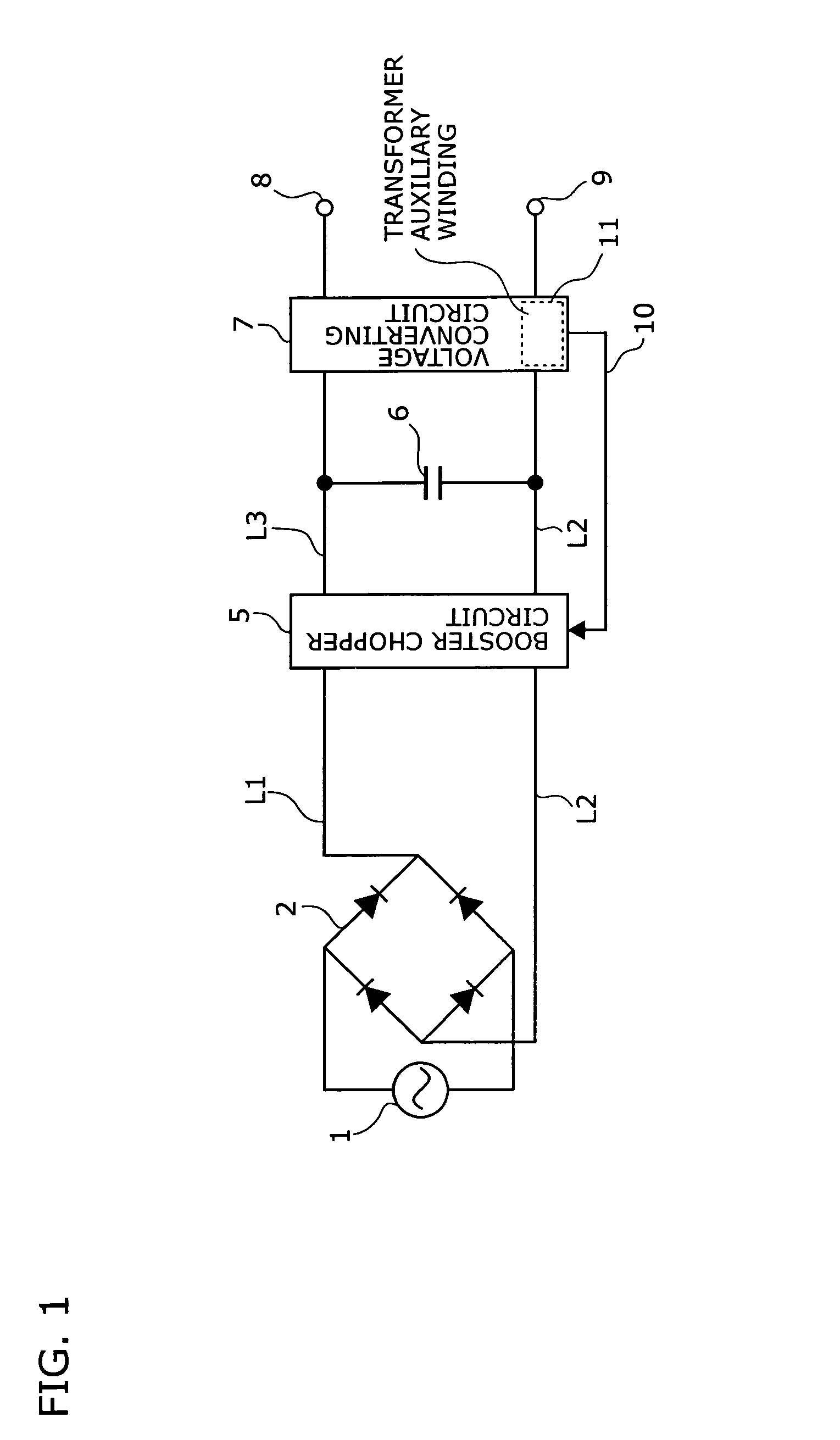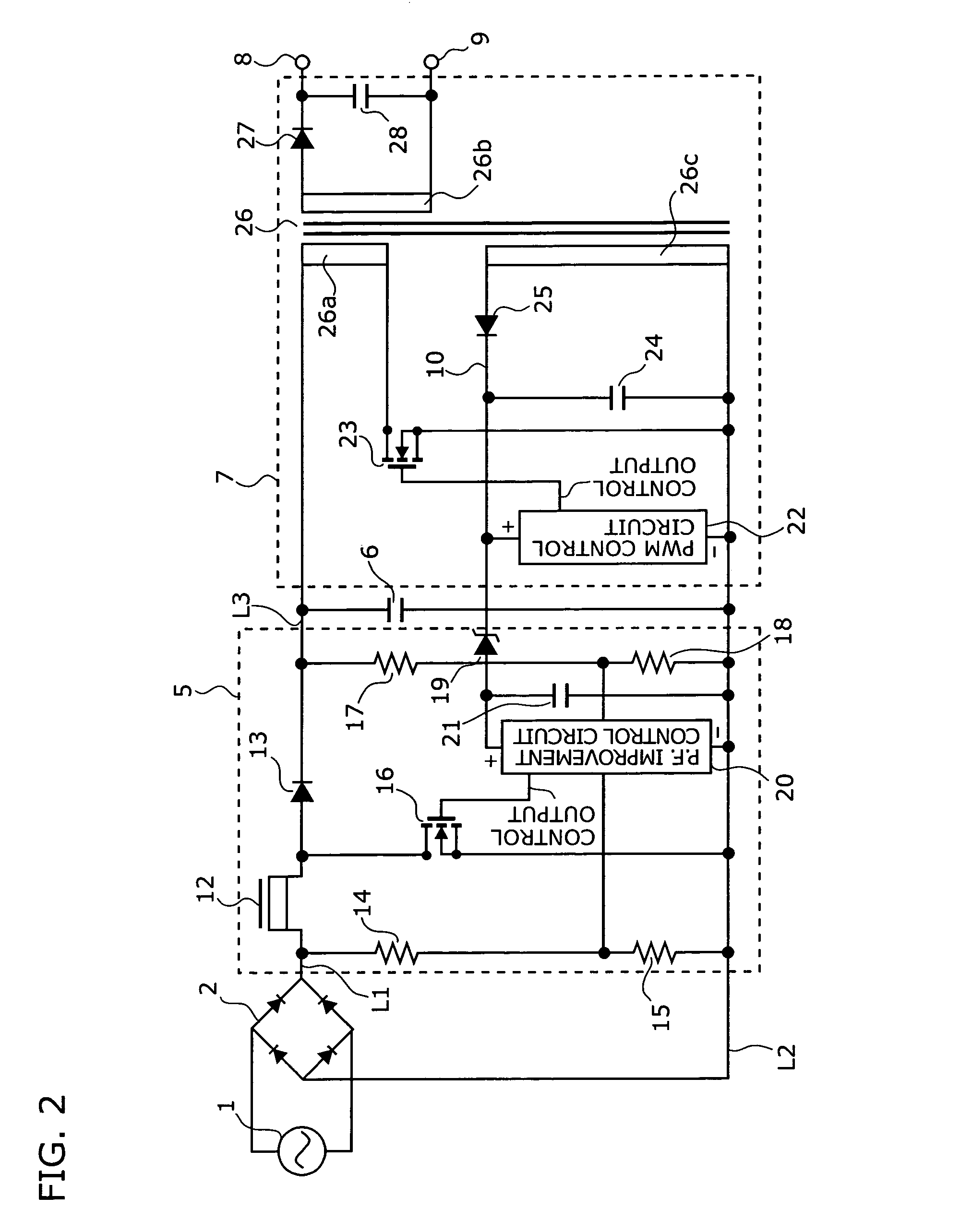Switching power supply device
a power supply device and power supply technology, applied in the direction of electric variable regulation, process and machine control, instruments, etc., can solve the problems of power factor reduction, power loss, conversion efficiency drop, etc., to reduce unnecessary power consumption, reduce driving voltage, and reduce unnecessary power consumption
- Summary
- Abstract
- Description
- Claims
- Application Information
AI Technical Summary
Benefits of technology
Problems solved by technology
Method used
Image
Examples
first embodiment
[0036]FIG. 2 is a circuit diagram of a first embodiment showing a specific configuration of the switching power supply device shown in FIG. 1. This switching power supply device employs a flyback converter circuit in accordance with a PWM (Pulse Width Modulation) control system. This switching power supply device comprises a bridge rectifier 2, a booster chopper circuit 5, a smoothing capacitor 6, and a voltage converting circuit 7.
[0037]An AC power source 1 is connected to an input side of the bridge rectifier 2, and a positive line L1 and a negative line L2 are connected to an output side of thereof. A series circuit comprising resistors 14 and 15 is connected between the positive line L1 and the negative line L2. The positive line L1 is connected to a positive line L3 by way of a chopper coil 12 and a diode 13. An FET 16 is connected between a connection point of the copper coil and the diode 13 and the negative line L2. The smoothing capacitor 6 and a series circuit comprising r...
second embodiment
[0045]FIG. 3 is a circuit diagram of a second embodiment showing a specific configuration of the switching power supply device shown in FIG. 1. In FIG. 3, such components as are found also in FIG. 2 are identified with the same reference symbols or numerals and descriptions thereof are not repeated accordingly.
[0046]A switching power supply device shown in FIG. 3 has a resistor 29 that replaces the Zener diode 19 of the switching power supply device shown in FIG. 2. When this switching power supply device is operating in a low-power consumption state and a PWM control circuit 22 is in an intermittent oscillation mode, in a period during which the PWM control circuit 22 stops functioning, a voltage induced in an auxiliary winding 26c drops. When this voltage is further reduced by being consumed as a voltage drop across the resistor 29 and by the smoothing capacitor 21 and becomes lower than an operating voltage of a power-factor improvement control circuit 20, the power-factor improv...
third embodiment
[0047]FIG. 4 is a circuit diagram of a third embodiment showing a specific configuration of the switching power supply device shown in FIG. 1. In FIG. 4, such components as are found also in FIG. 2 are identified with the same reference symbols or numerals and descriptions thereof are not repeated accordingly.
[0048]In a switching power supply device shown in FIG. 4, a diode 30 is provided in addition to a diode 25. An anode of the diode 30 is connected to one end of an auxiliary winding 26c of a transformer 26, and a cathode of the diode 30 is connected to a cathode of a Zener diode 31. This means that a power-factor improvement auxiliary power 38a arranged for a power-factor improvement control circuit 20 is provided separately from a switching control auxiliary power 38b arranged for a PWM control circuit 22. A voltage induced in the auxiliary winding 26c is rectified and smoothed by the diode 30 and a smoothing capacitor 21 and supplied to the power-factor improvement control cir...
PUM
 Login to View More
Login to View More Abstract
Description
Claims
Application Information
 Login to View More
Login to View More - R&D
- Intellectual Property
- Life Sciences
- Materials
- Tech Scout
- Unparalleled Data Quality
- Higher Quality Content
- 60% Fewer Hallucinations
Browse by: Latest US Patents, China's latest patents, Technical Efficacy Thesaurus, Application Domain, Technology Topic, Popular Technical Reports.
© 2025 PatSnap. All rights reserved.Legal|Privacy policy|Modern Slavery Act Transparency Statement|Sitemap|About US| Contact US: help@patsnap.com



